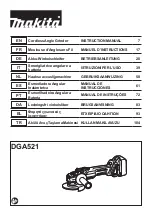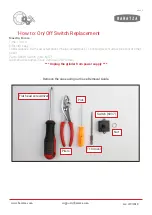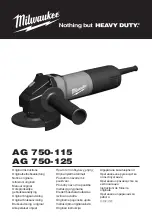
14 ENGLISH
When using a wire wheel brush
Optional accessory
CAUTION:
Do not use wire wheel brush that
is damaged, or which is out of balance.
Use of
damaged wire wheel brush could increase potential
for injury from contact with broken wires.
CAUTION:
ALWAYS use guard with wire
wheel brushes, assuring diameter of wheel fits
inside guard.
Wheel can shatter during use and
guard helps to reduce chances of personal injury.
►
Fig.14:
1.
Wire wheel brush
2.
Wheel guard
Installing or removing X-LOCK wheel
WARNING:
Never actuate the release lever of
the X-LOCK holder during operation. Make sure
that the X-LOCK wheel has stopped completely
when removing it.
Otherwise, the X-LOCK wheel
comes off from the tool and may cause serious injury.
CAUTION:
Use only original X-LOCK wheels
with the X-LOCK logo.
This tool is dedicated to
X-LOCK.
The maximum clamping gauge of 1.6 mm can only be
guaranteed with original X-LOCK wheels.
Use of any other wheels may lead to insecure clamp
-
ing, and cause the clamp tool to come loose.
CAUTION:
Do not touch the X-LOCK wheel
immediately after operation.
It may be extremely
hot and could burn your skin.
CAUTION:
Make sure that the X-LOCK wheel
and holder of the tool are not deformed and are
free from dust or foreign matters.
CAUTION:
Do not put your finger near the
holder while installing or removing the X-LOCK
wheel.
It may pinch your finger.
CAUTION:
Do not put your finger near the
release lever while installing the X-LOCK wheel.
It
may pinch your finger.
NOTE:
No additional parts such as inner flanges
or lock nuts are required to install or remove the
X-LOCK wheels.
1. To install the X-LOCK wheel, make sure that both
catches are in the unlocked position.
If not, push the release lever from A side to lift B
side, then pull the release lever from B side as
illustrated. The catches are set in the unlocked
position.
►
Fig.15:
1.
Catch
2.
Release lever
2. Place a central position of the X-LOCK wheel on
the holder.
Make sure the X-LOCK wheel is parallel to the
flange surface and with the correct side facing up.
3. Push the X-LOCK wheel into the holder. The
catches snap into the lock position with a click and
fix the X-LOCK wheel.
►
Fig.16:
1.
X-LOCK wheel
2.
Holder
3.
Flange sur
-
face
4.
Catch
4. Make sure the X-LOCK wheel is fixed correctly.
The surface of the X-LOCK wheel is no higher
than the surface of the holder as shown in the
figure.
If not, the holder must be cleaned or the X-LOCK
wheel must not be used.
►
Fig.17:
1.
Surface of the holder
2.
Surface of the
X-LOCK wheel
To remove the X-LOCK wheel, push the release lever
from A side to lift B side, then pull the release lever from
B side as illustrated.
The X-LOCK wheel is released and can be removed.
►
Fig.18:
1.
Release lever
OPERATION
WARNING:
It should never be necessary to
force the tool.
The weight of the tool applies ade-
quate pressure. Forcing and excessive pressure
could cause dangerous wheel breakage.
WARNING:
ALWAYS replace wheel if tool is
dropped while grinding.
WARNING:
NEVER hit the workpiece with the
wheel.
WARNING:
Avoid bouncing and snagging
the wheel, especially when working corners,
sharp edges etc.
This can cause loss of control and
kickback.
WARNING:
NEVER use tool with wood cutting
blades and other saw blades.
Such blades when
used on a grinder frequently kick and cause loss of
control leading to personal injury.
WARNING:
Never actuate the release lever of
the X-LOCK holder during operation.
The X-LOCK
wheel comes off from the tool and may cause serious
injury.
WARNING:
Make sure that the X-LOCK wheel
is fixed firmly.
CAUTION:
Never switch on the tool when it
is in contact with the workpiece, it may cause an
injury to operator.
CAUTION:
Always wear safety goggles or a
face shield during operation.
CAUTION:
After operation, always switch off
the tool and wait until the wheel has come to a
complete stop before putting the tool down.
CAUTION:
ALWAYS hold the tool firmly with
one hand on housing and the other on the side
grip (handle).
Summary of Contents for X-LOCK LXT DGA521
Page 2: ...2 1 3 Fig 1 1 2 Fig 2 1 Fig 3 1 Fig 4 1 Fig 5 1 Fig 6 Fig 7 2 ...
Page 3: ...3 2 1 Fig 8 2 B 1 A B Fig 9 2 B 1 A B B C C Fig 10 1 2 Fig 11 1 2 Fig 12 3 ...
Page 4: ...1 Fig 13 1 2 Fig 14 1 2 A B Fig 15 2 4 3 1 Fig 16 1 2 Fig 17 1 A B Fig 18 4 ...
Page 5: ...15 Fig 19 Fig 20 Fig 21 Fig 22 Fig 23 1 2 Fig 24 1 Fig 25 5 ...
Page 6: ...2 6 7 4 5 2 3 1 Fig 26 6 ...
Page 114: ...114 ...
Page 115: ...115 ...















































